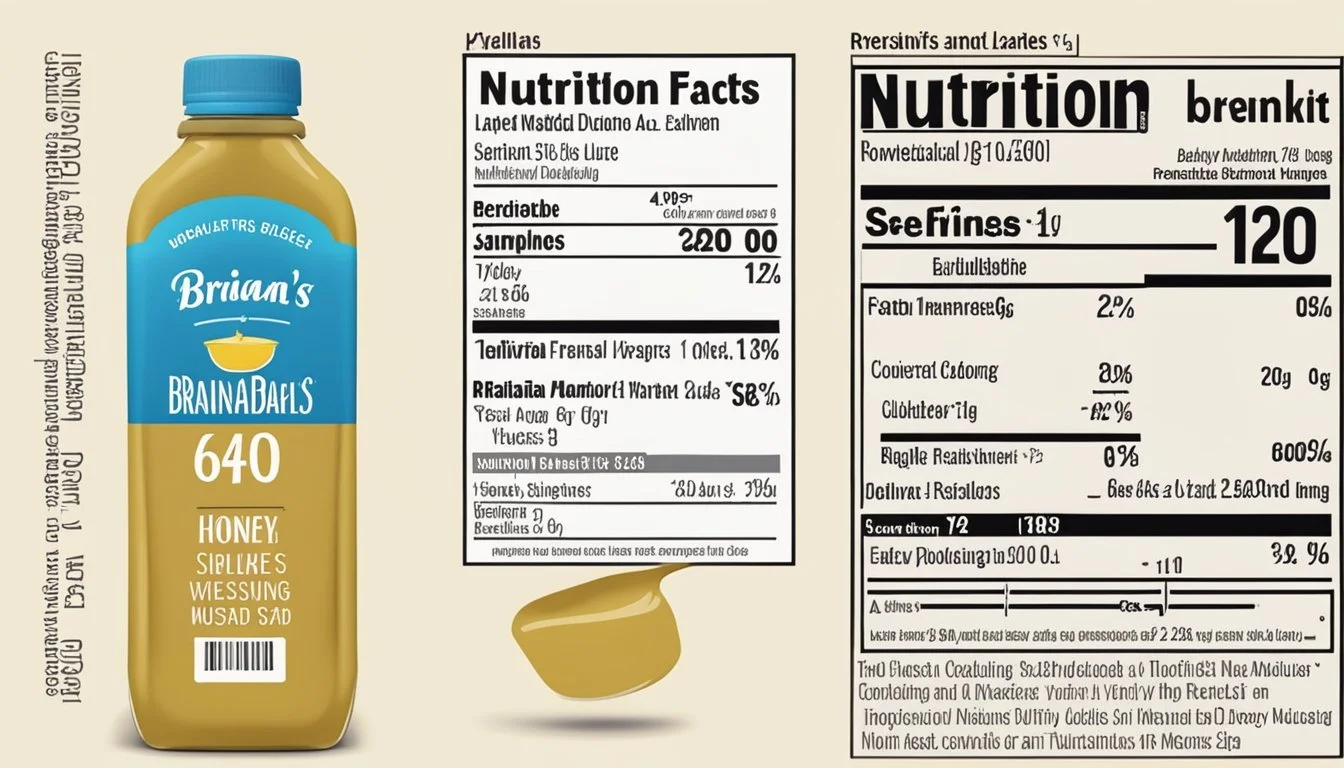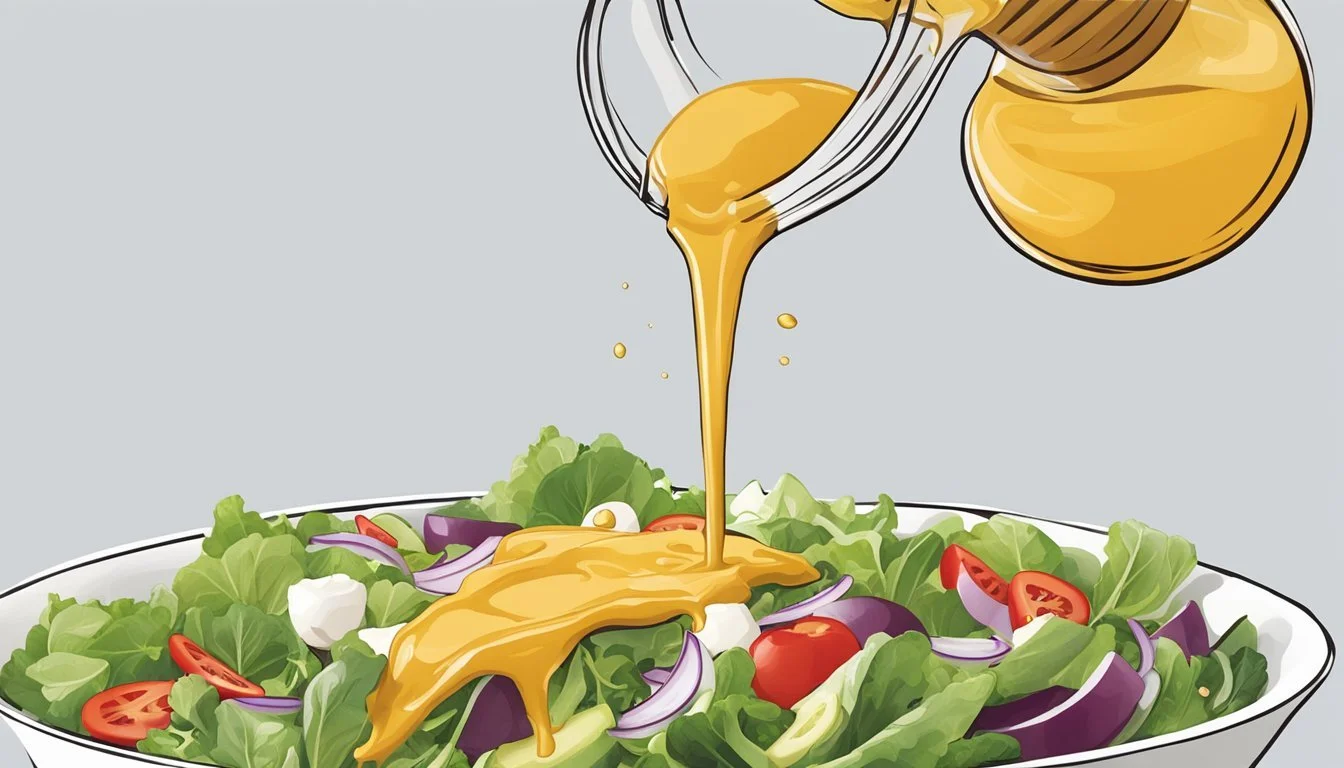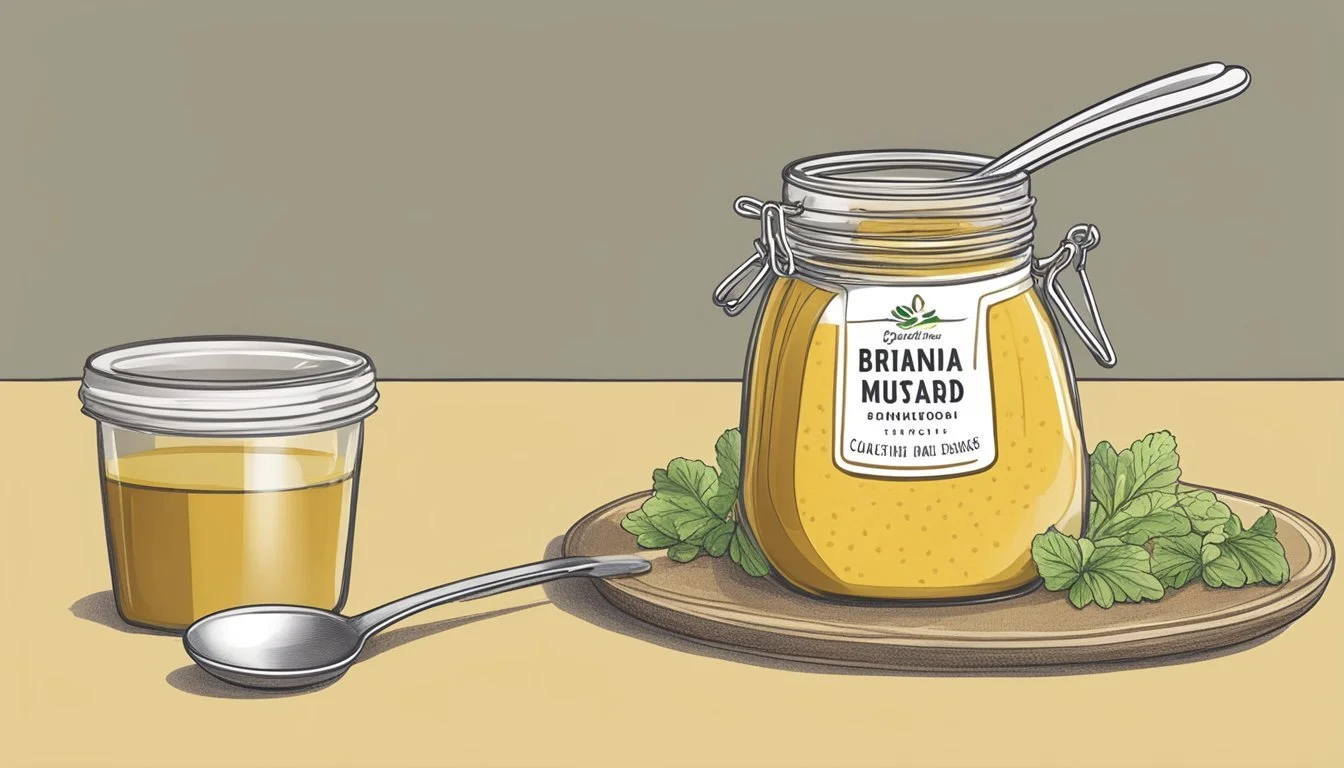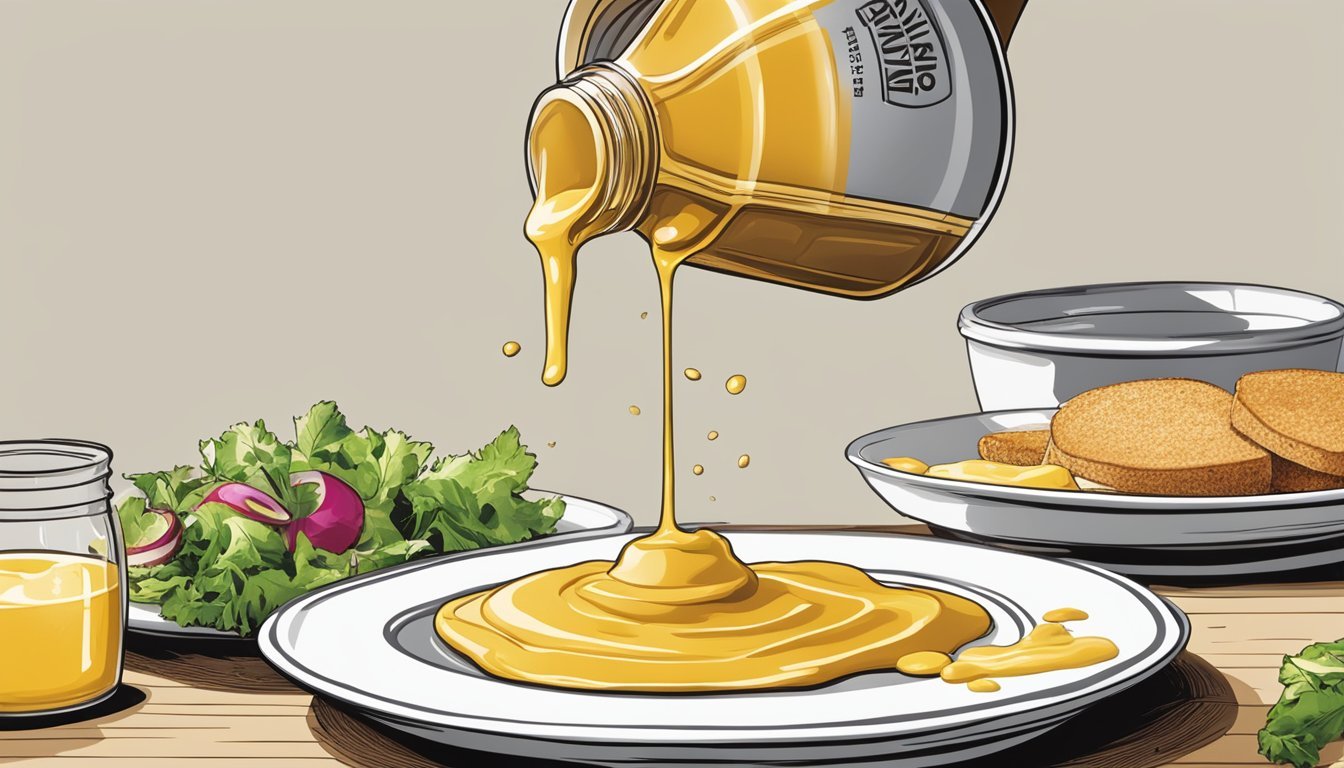How Much Brianna's Honey Mustard Dressing Per Day
Setting Healthy Limits
Determining how much honey (What wine goes well with honey?) mustard dressing is too much can depend on individual dietary needs and health goals. Brianna's honey mustard dressing, known for its unique blend of robust Dijon mustard and sweet honey, offers a flavorful option for salads and can also be used as a dip. However, like all dressings and condiments, it contains calories and fats that can add up quickly if not measured.
Moderation is key when incorporating dressings into a healthy diet. While Brianna's honey mustard dressing is gluten-free, kosher-certified, and free from high-fructose corn syrup and MSG, it still contributes to the overall daily intake of sodium, calories, and fats. The impact on one's diet must be considered in the context of everything else eaten throughout the day.
Understanding Honey Mustard Dressing
Honey mustard dressing is a versatile condiment renowned for its balance of sweetness and tanginess. By evaluating its key components, flavor nuances, and varieties, one can appreciate the multifaceted uses of this popular dressing.
Key Ingredients
The foundation of honey mustard dressing is a blend of honey and mustard, often Dijon mustard for its smooth consistency and sharp taste. Vinegar is regularly used to add acidity, which can range from white vinegar to apple cider vinegar. For sweetness and to promote consistency, ingredients like sugar or modified tapioca starch might be included. To achieve the desired thickness, xanthan gum, a common thickening agent, is included. Enhancements are often made using spices, onion powder, and turmeric for color and flavor. Some variations also contain sea salt, kosher certifications, and preservatives like citric acid or tartaric acid.
Flavor Profile
The hallmark of honey mustard dressing is its distinctive mix of sweetness from the honey, countered by the zesty and slightly spicy flavor of mustard seed, often found in the form of Dijon mustard. The choice of vinegar affects the overall tanginess, with more assertive vinegars like white vinegar contributing a sharper taste compared to the milder apple cider vinegar. Enhancers like onion powder and spices contribute to the complexity of the flavor profile, which can range from mildly tangy to robustly piquant.
Varieties
There is an array of honey mustard dressings available, ranging from creamy to vinaigrette-style dressings. The creamy type typically has a base of mayonnaise or similar emulsified substances, which are thickened with modified tapioca starch or xanthan gum. Vinaigrettes are lighter and blend honey, mustard, and vinegar without the creamy base. Within these categories, the flavor can vary significantly depending on the use of additional ingredients like mustard flour, mustard flavor, or even sea salt. More gourmet varieties may include unique blends of spices or incorporate kosher certifications to meet specific dietary needs.
Nutritional Information
In discussing the nutritional content of Brianna's honey mustard dressing, it's essential to analyze its makeup in terms of fats, proteins, sugars, and other micronutrients, alongside how to interpret the information provided on food labels.
Macronutrients
Calories: Each 2 tablespoon (30 ml) serving of Brianna's Dijon Honey Mustard Dressing contains 150 calories.
Nutrient Amount Per Serving Total Fat 14g Saturated Fat 1g Trans Fat 0g Protein 0g Total Sugars Not specified Dietary Fiber 0g
The dressing is high in total fat, particularly concerning for those monitoring their fat intake.
Micronutrients
Though specific quantities are not detailed in the search results, the dressing likely contains minimal micronutrients due to the absence of protein and dietary fiber. Trace amounts of:
Vitamin E
Calcium
Iron
Potassium
may be present, which play roles in various bodily functions. However, without precise data, one cannot rely on the dressing as a significant source of micronutrients.
Understanding Food Labels
The percentage of Daily Values (%DV) on the label allows consumers to gauge the nutritional content relative to a standard 2,000 calorie diet. For instance:
Total Fat: 14g, equating to 18% DV
Saturated Fat: 1g, equating to 5% DV
Cholesterol: 0mg, equating to 0% DV
These figures help in understanding the contribution of each serving of dressing to one's daily nutritional needs. The absence of trans fat and cholesterol is a positive, yet the high fat content may require moderation in consumption.
Health Considerations
When discussing Brianna's Honey Mustard Dressing, it is imperative to consider not only the flavor but also the health implications of its consumption. Specific attention should be given to potential allergens, dietary restrictions, and the effects of overconsumption.
Allergens and Sensitivities
Brianna's Honey Mustard Dressing contains ingredients such as mustard and honey which can trigger allergic reactions in some individuals. Those with sensitivities to these ingredients should avoid this dressing. Additionally, the dressing contains white wine and tartaric acid, which are less common allergens but can still cause adverse reactions.
Dietary Restrictions
For individuals following specific diets, the dressing's constituents are crucial to consider:
Vegetarian: Suitable for vegetarians, as it contains no meat products.
Vegan: Not suitable for vegans since it contains honey.
Gluten-Free: The dressing is labeled gluten-free, catering to those with celiac disease or gluten sensitivity.
No HFCS: There is no high fructose corn syrup (HFCS) listed in the ingredients.
No MSG: Monosodium glutamate (MSG) is not included in the dressing.
Effects of Overconsumption
Overindulging in Brianna's Honey Mustard Dressing can lead to excessive intake of fat and sodium, which are two nutrients of concern in many condiments. Here are the specifics per serving size of 2 tablespoons (31g):
Nutrient Amount % Daily Value* Calories 140 - Total Fat 12g 15% Sodium - -
It's important to note that moderate consumption is key to maintaining a balanced diet. Excessive intake of dressings with high fat and sodium content can contribute to long-term health issues such as heart disease and high blood pressure. It is recommended that individuals adhere to the American Heart Association's guidance for saturated fat and sodium intake.
Culinary Uses
Brianna's Dijon Honey Mustard Dressing, known for its robust Dijon mustard and sweet honey flavor profile, serves as a versatile condiment in the culinary world. Its applications range from enhancing fresh salads to marinating meats and serving as a rich dipping sauce.
Salad Applications
Brianna's Honey Mustard Dressing shines as a salad dressing, where it can be used to dress a wide range of salads. Here are specific ways to incorporate it into salads:
Green Salads: A drizzle enhances the flavors of salads containing avocado, mixed greens, and even fruit elements such as sliced peaches.
Pasta and Potato Salads: The dressing adds a creamy, tangy element to these heartier varieties.
Cooking and Marinades
The dressing's bold taste makes it an excellent marinade for proteins. Incorporating Brianna's Dijon Honey Mustard Salad Dressing into cooking can elevate the flavor of many dishes:
Chicken: It acts as a marinade that tenderizes and infuses chicken with moisture and flavor.
Ham: Brushing the dressing onto ham before baking creates a glazed finish.
Dipping Sauces
As a dipping sauce, Brianna's Honey Mustard Sauce complements a variety of snacks and finger foods:
Veggies: Vegetables like carrots and celery sticks are well-paired with the dressing as a dip.
Egg Rolls and Chicken Tenders: The sweet and tangy profile of the honey mustard dressing makes it an ideal complement to savory items like egg rolls and chicken tenders.
Storage and Preservation
When it comes to Brianna's Honey Mustard Dressing, maintaining its quality involves understanding its shelf life and employing proper storage methods. Adherence to these guidelines ensures the dressing remains safe to consume and retains its intended flavor profile.
Shelf Life
Brianna's Honey Mustard Dressing is an emulsified condiment, a mixture of oil, vinegar, and other ingredients. Upon opening, it should be enjoyed within a timeframe that preserves its freshness and taste. Typically, it can last for:
Unopened: Up to the date indicated on the label.
Opened: Approximately 6-9 months, if stored correctly.
Manufacturers may include tocopherols (natural antioxidants) that help to prolong the shelf life and integrity of the dressing by preventing the oxidation of fats like monounsaturated and polyunsaturated fats.
Proper Storage Methods
To maximize longevity and safety, one must follow these storage steps:
Refrigerate: Always refrigerate after opening. Keep the temperature at or below 40°F (4°C).
Seal Tightly: Ensure the cap is tightly secured after use to prevent contamination and oxidation.
Avoid Cross-Contamination: Use clean utensils each time to keep the dressing free of food particles.
These measures are essential to maintain the dressing's quality and protect it from spoilage.
Buying Guide
When selecting a honey mustard dressing, one should focus on the ingredient list and quality indicators to ensure they are choosing the best product for their dietary needs and taste preferences.
Label Reading Tips
Understanding the label is crucial for making an informed choice. Pay attention to the following:
Ingredients: The ingredients should be listed in descending order by weight. Look for dressings with natural ingredients, such as canola oil or olive oil, which are commonly used as a base.
Nutritional Content: Verify the nutritional facts, assessing calorie content and whether the dressing is high in sugars or fats.
Allergens and Dietary Requirements: Check for certifications like kosher or gluten-free if one has dietary restrictions.
Additives: Look for labels that say "No MSG," "No artificial colors," or "No high fructose corn syrup" to avoid unwanted additives.
Vinegar Content: Quality dressings may include vinegars like white wine vinegar. The presence and quality of vinegar can affect overall taste.
Quality Markers
The quality of a dressing can often be determined by these indicators:
Oil Type: High-quality dressings often use canola or olive oil as healthier fat options.
Flavor Profile: A good balance of sweetness from honey and the tanginess of mustard and vinegar should be apparent.
Consistency: A well-emulsified dressing indicates good quality. Separation of oil and other components can be a sign of lesser quality.
Packaging: Packaging that protects the contents from light and air helps preserve freshness. Clear indications of the dressing's features on the label, such as "Contains Real Honey" or "Made with White Wine Vinegar," can also guide decisions.
DIY Honey Mustard Recipes
Creating a homemade honey mustard dressing allows for control over ingredients and flavor adjustments to suit individual taste preferences. This section offers a basic recipe and suggestions for enhancing the flavor.
Homemade Dressing
To prepare a simple yet delicious honey mustard dressing, one will need honey, Dijon mustard, apple cider vinegar, salt, and black pepper as core ingredients.
Ingredients:
1/4 cup Dijon mustard
1/4 cup honey
1/4 cup apple cider vinegar
1/2 teaspoon salt
1/4 teaspoon black pepper
Instructions:
In a bowl, whisk together the mustard and honey.
Add the apple cider vinegar, salt, and black pepper.
Continue to whisk until the ingredients are well combined and the dressing achieves a creamy consistency.
For a thicker dressing, one may opt to incorporate mayonnaise to achieve the desired texture.
Custom Flavor Enhancements
The basic honey mustard recipe can be personalized with additional ingredients to cater to specific palates.
To Add Sweetness:
Increase the amount of honey slightly.
Incorporate a teaspoon of white wine for a subtle fruitiness.
To Introduce Complexity:
A pinch of ground black pepper can add an extra layer of spice.
For those who enjoy a tangy kick, adding more apple cider vinegar incrementally can sharpen the flavor.
Remember that the key to a successful dressing lies in balancing the sweet and tangy elements according to one's own preference, ensuring the end product complements the dish it accompanies.
Frequently Asked Questions
In this section, we address common inquiries about the consumption of Brianna's Honey Mustard Dressing, focusing on usage recommendations and health-related questions.
Usage Recommendations
When considering how much Brianna's Honey Mustard Dressing to use, it’s important to balance flavor and dietary preferences. Most salad dressings, including those from Brianna's, suggest a serving size of approximately 2 tablespoons per salad. However, the ideal amount can vary based on the individual's taste and the size of the salad. For applications other than salads, such as dips or marinades, usage will depend on the quantity of food being prepared and personal taste.
Health and Nutrition Queries
Concerning health and nutrition, Brianna's Honey Mustard Dressing should be consumed in moderation, as with any condiment. It's important to consider the caloric and sugar content, especially if one is monitoring their dietary intake. The dressing is gluten-free, vegetarian, and does not contain high fructose corn syrup (HFCS) or monosodium glutamate (MSG). Keeping an eye on ingredient labels is key for those with specific dietary restrictions or health goals. A balanced diet that includes a wide variety of foods should allow for occasional condiment use like honey mustard dressing without exceeding recommended daily intakes of calories and sugars.










